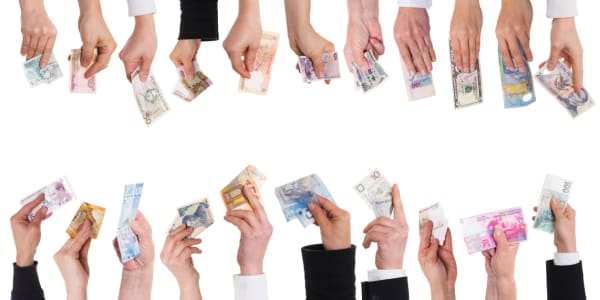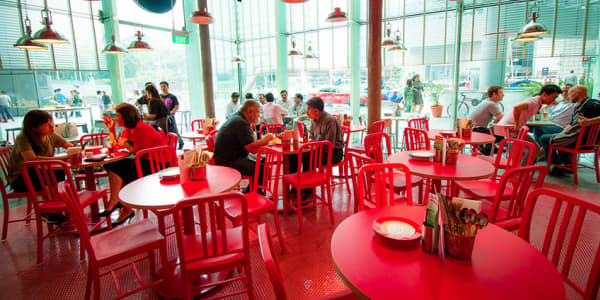They may be wacky and weird but sure make business sense. What are we talking about? Bizarre "Made in Asia" innovations that have caught the consumer's imagination.
Quirky and odd, these products have found a niche in the marketplace as they cater to a need or simply to a fetish.
We have scouted around and come up with a list of eight such fascinating ideas that make you wonder "why couldn't I think of that?"
Click ahead for a sample of some of the craziest yet successful businesses out of Asia.
By Rajeshni Naidu-Ghelani
(Posted April 22, 2013)
Modern Toilet Restaurant
Eating ice cream shaped like poop while sitting on a toilet bowl in public - disgusting? Apparently not in Taiwan, where a chain of bathroom-themed restaurants called the Modern Toilet is big business.
The Modern Toilet restaurant was founded in 2004 by former banker Wang Zi-Wei after he saw success selling chocolate ice cream in containers shaped like squat toilets. Since then, the restaurant has expanded to 12 locations in Taiwan, along with one restaurant in Hong Kong.
The eatery's "out-there" design includes toilets seats as chairs, bathroom sinks covered with glass top as tables and toilet roll dispensers hanging on the wall. Drinks come in urinal shaped containers and meals are served in dishes resembling bathtubs.
The restaurant chain is a key attraction in Taiwan. It has a three and half star rating from travel website TripAdvisor, and was recently featured on the lifestyle TV channel TLC in a show titled the "World's Weirdest Restaurants." Taiwan is also home to other wacky restaurants like those inspired by hospitals and jailhouses.
Canned Fresh Air
Air quality has gotten so bad in China that one entrepreneur is cashing in on the smog selling cans of fresh air.
Chinese multi-millionaire Chen Guangbiao, who made his fortune in the recycling business, handed out (pictured) soda pop-sized cans of air, reportedly collected from remote and pristine regions of China like Xingjian in the north-west. The air was distributed in January when residents of Beijing were choking on toxic smog. According to Chen, he sold eight million of these cans priced at 5 yuan (50 cents) each in the last 10 days of January when air quality was exceptionally poor.
The canned air comes in a variety of flavors like "pristine Tibet," and "revolutionary Yan'an," the Communist Party's early base. It was introduced in mid-2012 but gained popularity this year, according to local media reports. Chen has said he donates the proceeds from the sales to the poorer regions of China.
Square Watermelons
Messing around with nature has led to what's being called one of Japan's greatest innovations - square watermelons.
Farmers in the southern Japanese region of Zentsuji started growing watermelons in glass boxes letting them naturally take the cubic shape of the boxes. Square watermelons as opposed to oval ones are easier to store in refrigerators. While news of the square watermelons started spreading in 2001, Japanese farmers have reportedly been growing these square melons for more than 30 years. Hugely popular in the country, the watermelons sell anywhere from $150 to $250 a piece. Regular round watermelons sell for about $30.
A fruit producer from Panama, called Panama Fruit Producer, caught on to the fad and has been growing and exporting these square watermelons to the U.S. and parts of Europe since 2010. They retail for a whopping $75 each.
9gag.com
Four Hong Kongers decided to have some fun and created a website called 9gag.com that allows users to upload funny pictures and videos which you can rate and comment on.
The website launched in 2008 has since gained a huge following if you go by its record on Facebook and Twitter - it has crossed five million monthly Facebook "shares" and has more than 1.5 million followers on Twitter. The website is one of the world's largest and fastest growing humor websites - seeing 70 million unique visitors and more than one billion page views per month, according to 9gag. The U.S. is the website's largest market, accounting for 12 percent of total traffic, according to 9gag.
In July last year, the firm announced that it had secured $2.8 million in funding to increase staff and expand internationally. The company also launched a new mobile app for its widely popular content on Apple's iOS and Android platforms in July.
Kopi Luwak
One of the most expensive coffees in the world, Kopi Luwak, is derived from - believe it or not - the poop of a toddy cat.
Kopi Luwak, or civet coffee refers to the beans of coffee berries that are eaten by the Asian Palm Civet, the long bodied mammal who inhabits the jungles of South and Southeast Asia. After the beans ferment in the animal's stomach, they are gathered from the civet's droppings and cleaned and roasted.
The coffee originated in the 1800s in the Indonesian islands of Java and Sumatra, and is still big business in the country with coffee producing plantations across the islands. Its harvesting, however, has now also spread to other parts of Asia like Vietnam and the Philippines and even to Peru - the world's biggest producer and exporter of organic coffee - where beans are roasted from the dung of a raccoon like animal called the coati.
Coffee connoisseurs are willing to pay anywhere from $20 to $65 for a cup of the civet coffee and on Amazon.com the price of the beans range from $40 for 100 grams to nearly $350 for one kilogram. But before shelling out a premium for the drink, consumers should be aware that there is a growing market of fake civet beans. In Vietnam, nearly every vendor in the country's highlands coffee-growing region claims to sell civet coffee for a cheaper price, according to media reports.
Pocket Geiger
It's so small it can fit in a pack of mints and that's how it's being marketed. But, the Pocket Geiger has a much bigger purpose - it is the first device ever that can detect radiation with the help of a smartphone.
Invented by a Japanese non-profit organization Radiation Watch in 2011, the Pocket Geiger can measure the level of radiation in two minutes anywhere, according to its website. The device needs to be attached to an iPhone or Android phone and works in tandem with an accompanying app by using eight photodiode sensors to detect the levels of radiation. The app is also designed to upload individual readings onto a central database, which is then aggregated by Radiation Watch and displayed on a map available to over 10,000 members.
The device comes in several versions that cost between $20 and $70. In December, Radiation Watch founder Yang Ishigaki was quoted as saying to local media that the company has sold about 20,000 of the Geiger counters so far. The product is being sold on online retailers Amazon and eBay.
Odor Absorbing Underwear
An Australian entrepreneur has invented an underwear for men that traps smell. This odor-free pair of briefs can be bought online for $25-$35 under the 4SKINS brand.
Developed in 2010 by Gilbert Huynh, this underwear uses nanotechnology to prevent smells from passing through the fabric. Called Neutralizer, the fabric was invented by U.S. firm Nano-Tex and is used in sportswear. Huynh has been reported as saying that it's a top seller among women, who are buying them for their boyfriends and husbands.
Taking off from 4SKINS, a Japanese textile company - Seiren - introduced its own range of underwear that eliminates odors, making headlines in November last year. Seiren's Deoest underwear is coated with ceramic powder, which absorbs odors. Sales of the underwear have taken off in Japan, especially among businessmen, according to local reports, and the company's range has expanded to include 22 items like odor-absorbing socks and T-shirts.
Ashes to Beads
Staying close to your loved ones has taken on a new meaning in South Korea with the popularity of turning the ashes of dead relatives into gem-like beads.
The innovation stemmed from the government's cremation campaign in 2000, in which they encouraged people to cremate instead of bury the dead in order to save space. This campaign also led to a law being passed that required anyone burying their dead after the year 2000 to remove the grave 60 years later.
Since then, niche ashes-to-beads companies have seen a steady growth in their business, according to local reports. Bonhyang, a company based in Icheon, just south of the capital Seoul, uses ultrahigh temperatures to melt cremated ashes until they are crystallized and can be turned into beads in a 90-minute process. Bonhyang founder Bae Jae-yul wasn't the first to use the technology in South Korea, but says he bought the technology from a meditation business in the late 1990s and spent several years refining the process.
The pebble-sized gems cost about $900, according to media reports. Jae-yul has been quoted as saying that he's served more than 1,000 customers in 10 years and Buddhist temples have leased his bead-making machines.




